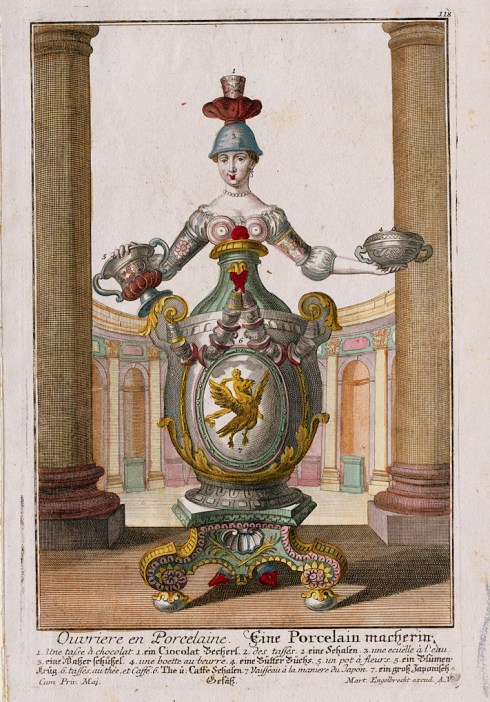I’m looking forward to the Valentine’s Day opening of the exhibit “Cosmopolitan Consumption: New England Shoe Stories, 1750-1850” at the Portsmouth Athenaeum: it is co-curated by my friend Kimberly Alexander and strikes me as the perfect afternoon activity for that particular day (of course I am female). You can read much more about the exhibit on Kimberly’s blog: SilkDamask. I want to see amazing shoes and support my friend, but she had me as soon as I saw the invitation, which features one of my favorite early modern genres, which I will call “occupational art”. The image is by Martin Engelbrecht (1684-1756), an entrepreneurial artist and publisher from Augsburg who produced 170 “Mr. and Mrs.” engravings for his series Artists, Craftsmen, and Professionals (circa 1730). On the invitation, appropriately, we see the wife of a shoe peddler, and while I haven’t been able to source her partner in peddling, I did find another very striking couple, the porcelain maker and his wife, at the Winterthur Museum.
This genre seems to have two categories: the fantastic–even grotesque–and the realistic. Engelbrecht’s images fall squarely in the former, and while he appears to have been an innovator in many aspects of his business, these creative composites were nothing new. The depiction of people as assemblages of objects goes back to the Renaissance, and his near contemporaries Nicolas de Larmessin and Gerard Valck produced even more fantastic occupational images decades before him. Engelbrecht’s women are unique though: he even includes a lady cartographer and prosecutor! Images of real workers are going to have to wait for the nineteenth century for the most part, but in keeping with the shoe theme here are Valk’s and Larmessin’s leather workers, in all of their glory.
Gerard Valck’s Habit de Cordonnier (c. 1700) from the invitation to the Bata Shoe Museum’s 2012 exhibition, Art in Shoes~Shoes in Art; Nicolas II de Larmessin’s Habit de Cordonnier and Habit de Sauetier from his Les costumes Grotesques: Habits des métiers et professions, c. 1695, Museum of Fine Arts, Boston and Bibliothèque nationale de France; Gerard Valck print of Habit de Ceinturier after Nicolas de Larmessin, c. 1695-1720, British Museum.













Leave a Reply